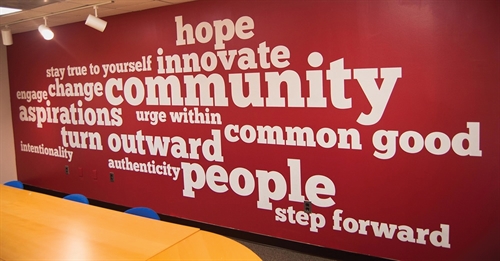October 2017 | Volume XXXV. Issue 5 »
Engagement Is the Word
September 29, 2017
David J. Seleb, Oak Park Public Library

How do we engage with our patrons and our communities? What does authentic engagement look like? How do we define and measure the success of our engagement and our impact on our communities? The Oak Park Public Library (OPPL) is just one of many libraries across the country concerned about the answers to these questions. And the answers for us in Oak Park, we have learned, lie in the discovery and the understanding of our community’s aspirations and in responding intentionally to those aspirations.
The Harwood Institute for Public Innovation (www.theharwoodinstitute.org), founded by Rich Harwood in 1988, developed a partnership in 2013 with the American Library Association (ALA) to introduce librarians and library staff members to Harwood’s time-tested and proven methods for authentic community engagement. That partnership has since evolved into ALA’s Libraries Transforming Communities (http://www.ala.org/tools/librariestransform/libraries-transforming-communities) initiative. Harwood refers to those committed to its principles as Public Innovators. As participants in Harwood’s first Public Innovators’ Lab designed specifically for libraries in October 2013, OPPL learned how to adopt Harwood’s tools and techniques to understand and respond to our community’s aspirations.
CHANGING OUR APPROACH
These Harwood methods include, among others, Community Conversations and Innovation Spaces, tools that ask questions such as, “What kind of community do you want to live in, why is that important, and what needs to happen to achieve that vision?” They also call us to reflect on questions such as, “What are we learning as a community or an organization, how do we respond to what we are learning, and what opportunities does that learning present to us?” The heart of the Harwood philosophy is “turning outward,” or making your community rather than your conference room the center of your work, as Rich Harwood says.
These methods, and the conversations we have had with our community in the months and years since 2013, changed in lasting ways how we think about our work and our services, how we plan, and how we act. We have taken a strategic plan full of objectives and actions that were internally driven and replaced it with one that responds directly to our community’s needs and desires.
Harwood speaks of public knowledge, the knowledge a person or organization obtains only through ongoing dialogue with a community. The public knowledge we have gained has revealed specific aspirations shared across the community, aspirations including diversity, inclusion, participation, equity, education, literacy, health, safety, and affordability. Our determination to respond positively to these aspirations has informed the development of our strategic plan, a plan now focused on our three priorities of engagement, learning, and stewardship. Just last month, I was asked to share a success inspired by this new engagement, to which I replied it would be difficult to name any work we are doing that is not directly related.
PUTTING IT INTO ACTION
Among the most positive responses was our decision in 2016 to implement a social work model of engagement. If we were determined to prove our commitment to the community’s aspirations—especially those of diversity, inclusion, and equity—we knew we had to transform the ways in which we engaged with the most vulnerable, marginalized, and excluded members of our community. Who does that include? Certainly it includes those in our community who are experiencing homelessness. It also includes youth at risk and seniors who may be disconnected from family and community for varied reasons. It includes those facing the challenges of mental illness or drug addiction. It includes those marginalized or excluded from full participation in the community because of things such as race, or income, or employment status, or orientation. These individuals are among our patrons. They use our library every day and always have. What is different now is how we have chosen to engage them. Instead of focusing on troublesome or disruptive behaviors that require correction or problems that someone else should be fixing, we now see opportunities to reach out to engage and connect.
Our Manager for Community Resources, who is the library’s full-time social worker, manages five other staff members—one full-time Community Resources Specialist and four Safety and Security Monitors. All these individuals embrace our vision and mission, are trained in trauma-informed care, and in mental health first aid. All work closely with other staff members to provide a continuum of care model. All maintain strong connections to many community partners to connect patrons to needed resources, services, and support. These vital community partners include our school districts, Housing Forward, the Oak Park Coalition to End Homelessness, the Collaboration for Early Childhood, the Oak Park Police Department, and the Township of Oak Park among others.
This work is about focusing on the community, its aspirations, and its needs. It is about recognizing the opportunities for authentic community engagement and taking intentional action to effect community change. It is about shifting resources to achieve important community objectives. It is about leveraging strong and effective partnerships to obtain greater equity in service and access to resources. It is about the library working and collaborating to transform a community.
NOTE: The 4th Annual Public Innovators Lab for Libraries is being held October 18-20, 2017, in Atlanta, GA. http://theharwoodinstitute.org/labforlibraries/

 iREAD Summer Reading Programs
iREAD Summer Reading Programs Latest Library JobLine Listings
Latest Library JobLine Listings